

B H U T A N
NOTE: "HOME" takes you to our initial home
page; "UP" will return you
to the Round The World 2008 site for more exploring.
Wed, 15 Oct: The Kingdom of Bhutan is located north of India which surrounds its east, west and southern borders. Bhutan is separated from its northern neighbor, China, by the Himalaya Mountains.
We began our journey by taking Bhutan’s national airline, Druk Air, from Bangkok to Paro. It was a very early day since our flight departed at 5:50AM. We arrived at the airport at 4:00AM and it wasn’t a moment too soon. The staff had no record that we had been preapproved for a Visa upon landing. So, we had to make an emergency call to the US where our booking agent, Mark Sood, had to subsequently contact our booking agent in Bhutan who assured the airline that all appropriate paperwork had been filed with the government. So, we were allowed to board the plane just prior to its scheduled departure. Whew!
The flight itself was great as was the service provided by the staff. We had one stop at Gaya, India. Then, we enjoyed our first views of the Himalayas – spectacular! Once we arrived in Paro, our paperwork was indeed on file with the government authorities. We cleared immigrations & customs and were met by our guide, Anjana. She took us to our car and introduced us to our driver, Songay. Then, we began the 1.5 hour drive to Bhutan’s capital, Thimpu. En route we stopped to take photographs of a private Buddhist temple and a bridge used to access it as well as three stupas (Buddhist religious monuments) erected at the confluence of two rivers.
Click on the image to display a larger photo. Once
displayed,
click on the BACK button (first button on the left of your browser)
to return to this page.
Thimpu is a small charming city that sits 7,500 feet with hills on all sides. The buildings are all built in typical Bhutanese style. Also, individuals who work in offices and/or those conduct official business as well as those going to school wear the traditional garb. So, Thimpu presents a very unique picture to an outsider. After checking into our hotel, we went for a traditional Bhutanese lunch featuring all kinds of chile dishes eaten with rice. Each was delicious! Since we told Anjana that we love spicy food, she made sure we “got the real deal” and we enjoyed every bite!
After lunch we went to The Textile Museum which highlights Bhutan’s rich textile heritage (no photographs are allowed). Then we finished our first day of touring by visiting the King’s Memorial Chorten. This is a Tibeten-style chorten (stupa) built to honor the memory of Bhutan’s third king, the late King Jigme Dorji Wangchuk. It was a beautiful building!
Click on the image to display a larger photo. Once
displayed,
click on the BACK button (first button on the left of your browser)
to return to this page.
 |
The King's Memorial Chorten |
 |
A row of prayer wheels.
If you spin the wheel as you say a prayer, the prayer continues while the wheel spins |
Thu, 16 Oct: Today we had a very full day of touring around Thimpu. We began at the Folk Heritage Museum. This is an outdoor museum dedicated to presenting a glimpse into rural life in Bhutan. It features a farm house, garden, orchard, grinding mill and traditional prayer wheel and incense burning area.
Click on the image to display a larger photo. Once
displayed,
click on the BACK button (first button on the left of your browser)
to return to this page.
Next we visited the Zorig Chusum Institute. Here young people are taught in the fields of painting, wood carving, sculpture, embroidery and calligraphy. The articles they create are truly beautiful and each one learns skills useful for the balance of his/her life.
Click on the image to display a larger photo. Once
displayed,
click on the BACK button (first button on the left of your browser)
to return to this page.
 |
Traditional wood carving |
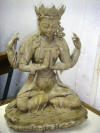 |
An intricate and beautiful sculpture |
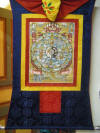 |
A traditional display drapery |
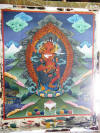 |
A painting rendered on cloth - amazing! |
 |
A class of individuals doing embroidary work |
Afterwards we visited a Traditional Medicine Institute where various plants are used to treat a variety of ailments. We also went to a Traditional Paper Factory where paper products are made.
After another delicious lunch, we visited a variety of spots. We drove about 100 meters above Thimpu to the Sangaygan View Point where we enjoyed great views of the town. On the way down, we stopped at Changangka Lhakhang (Changangka Temple) where we witnessed the traditional ceremony of a Buddhist priest selecting a name for an infant girl at the request of her parents.
We also visited Takin Park. Here we saw Bhutan’s treasured animal, the Takin. Based on ancient beliefs, it was created from the bones of a goat and cow after a feast and it than came to life and grazed. It’s quite true that the Takin has the head of a goat yet its body resembles that of a cow (in actuality, it is a mountain antelope). We also saw a couple of Barking Deer.
Click on the image to display a larger photo. Once
displayed,
click on the BACK button (first button on the left of your browser)
to return to this page.
We stopped by the Dubthob Nunnery at Zilukha. Here we were given holy water in the palms of our hands which we sipped and then used the balance to anoint our heads. The individual giving this to us was a young girl studying to be a nun.
Click on the image to display a larger photo. Once
displayed,
click on the BACK button (first button on the left of your browser)
to return to this page.
After a drive down and across town we went to Semtokha Dzong. This is the oldest fortress (dzong) in Bhutan, being built in 1629AD. Here we were allowed in the temple to see the altar to Buddha. The Dzong also houses one of the largest monastic schools in Bhutan.
Click on the image to display a larger photo. Once
displayed,
click on the BACK button (first button on the left of your browser)
to return to this page.
 |
Semtokha Dzong atop a hill |
 |
The entry to the Dzong |
 |
Anna and Jimmy (our second
driver) in front of the Dzong's Prayer Wheel |
Finally, we ended our day at Tashichho Dzong, now the Parliamentary Building. It has two functions – one being government administration and the other being monastic. The governmental area isn’t open to the public but we did go into the temple. The altar was gorgeous with a huge Buddha surrounded by carved wooden flowers painted in a variety of colors. It was the perfect way to end our touring for the day.
Click on the image to display a larger photo. Once
displayed,
click on the BACK button (first button on the left of your browser)
to return to this page.
Fri, 17 Oct: Today we left Thimpu early in the morning to explore the Punakha and Wangdue Valley. We began by driving approximately one hour to arrive at Dochula Pass at 10,000 feet. It was a beautiful day and we were so very lucky – we had incredible views of the Himalayas! It was absolutely spectacular and something that we will never forget. We took tons of photographs of the mountains and then tons of us and our guide and driver (Anjana & Jimmy). It was such a beautiful day we all wanted memories of it! Also, at the pass there is a group of 108 stupas which we photographed. Then we went to a tea shop and enjoyed sipping black tea while watching the beautiful vista. Simply incredible!
Click on the image to display a larger photo. Once
displayed,
click on the BACK button (first button on the left of your browser)
to return to this page.
 |
The high mountains as seen from Dochula Pass |
 |
Anajana and Jimmy at the Pass |
 |
One of the beautiful buildings |
We next made our way off the pass and down into the valleys below. While we had been cool in Thimpu and cold at the pass, it was very warm in the valley. Our first stop was the Wangdiphodrang Dzong. This huge fortress was built 1638AD. It is still a great and majestic building and its temples are very beautiful.
Click on the image to display a larger photo. Once
displayed,
click on the BACK button (first button on the left of your browser)
to return to this page.
 |
Wangdiphodrang Dzong |
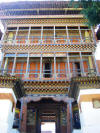 |
The entry gate at the Dzong |
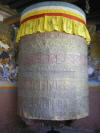 |
A giant metal Prayer Wheel |
 |
Monks walk along the interior courtyard |
 |
Well-used Prayer Wheels |
 |
A view of the vally from the Dzong |
Then, after a delicious lunch we went to Punakha Dzong, the former capital of Bhutan. The Dzong sits at the confluence of the Pho Chu and Mo Chu Rivers. This was probably the most beautiful temples we have seen in the world! It was even more beautiful due to colorful decorations being placed on it for the upcoming coronation of the Fifth King of Bhutan. Very, very impressive.
Click on the image to display a larger photo. Once
displayed,
click on the BACK button (first button on the left of your browser)
to return to this page.
We returned to Thimpu via the same route (over Dochula Pass) in late afternoon. While the Himalayas were still visible, they were not as crisp as we had seen early in the morning. They were nevertheless stunning but we stuck with our morning photographs to keep our memories.
Sat, 18 Oct: This morning we said goodbye to Thimpu and drove to Paro. Before beginning touring, we checked into the Gangtey Palace Hotel, the former residence of the Prime Minister. We had a beautiful room with great views of the Paro Dzong and its Watch Tower which is now the museum of National History.
Our first stop for the day was the Drukgyel Dzong. The Dzong was built in 1647 to commemorate the Bhutanese victory over the Tibetans in war of 1644. It has not been restored so it is a great contrast to those dzongs which have been maintained. Its location is impressive as it towers over the surrounding valley. From the Dzong, we had a great view of Mt. Jumolhari. The very top of the mountain was hidden in the clouds but it still was quite majestic.
Click on the image to display a larger photo. Once
displayed,
click on the BACK button (first button on the left of your browser)
to return to this page.
Next we visited the Kyichu Lhakhang (Kyichu Temple). The temple has both an ancient altar and one which was built in the 1980’s by the Queen Mother. We were extremely lucky that we were allowed to visit the Temple because the Queen Mother and her daughter were there praying. We were in the inner courtyard as they exited and we bowed in respect as Anjana had shown us to do. The Queen Mother smiled and then asked where we were from. We told her the United States. Next, she asked if this was our first visit to Bhutan. We told her it was but that we would definitely return. She asked if we enjoyed our visit and we told her it was wonderful. She then proceeded to leave with her entourage. We felt so blessed that the Queen Mother took the time to speak with us. Anjana also was very excited as she had been blessed by the Monk accompanying the Queen Mother. A wonderful experience for us all!
Click on the image to display a larger photo. Once
displayed,
click on the BACK button (first button on the left of your browser)
to return to this page.
 |
Inside the Temple Gate |
 |
Waiting in an interior
courtyard for the Queen Mother to finish her prayers (it was the first time we saw any guards at any site) |
After another delicious lunch, we visited the Dunguse Temple. It was built in the 15th century and has a vast collection of wall paintings. No lights have been installed so we visited the temple via candlelight.
Click on the image to display a larger photo. Once
displayed,
click on the BACK button (first button on the left of your browser)
to return to this page.
Our final stop of the day was at the Paro Dzong. First we visited the National Museum which is located in the former Watch Tower. It holds an impressive display of artifacts – both religious and everyday articles. Our favorite display was a photographic history of the Kings of Bhutan, beginning with the First King who was inaugurated in 1907.
We next walked down to the Paro Rinpung Dzong. It is a massive Dzong which is very beautiful. Both it and the Watch Tower sit high above Paro. We enjoyed walking through the various courtyards and enjoying the many wall paintings. Afterwards, we walked down a long pathway down the hill where our vehicle was waiting.
Click on the image to display a larger photo. Once
displayed,
click on the BACK button (first button on the left of your browser)
to return to this page.
 |
Paro Rinpung Dzong |
 |
Interior courtyard of the
Dzong which is intricately painted |
 |
A beautiful wall painting inside the Dzong |
We only took a very brief break at the hotel before leaving for the evening. In the Town Square, local school children performed a seven-set program of modern dance. Two of the presentations were done by children from the School for the Deaf which is located in Paro. Everyone did an excellent job and we thoroughly enjoyed ourselves.
We enjoyed a traditional dinner with Anjana and Jimmy before returning to the Gangtey Palace. It was another delicious, spicy meal. Before dinner we shared some of the photographs we took of each of them via a slide show on the laptop. They were very pleased and we promised to send printed copies of the photographs to each of them.
Bhutan is truly a special place! It has incredible natural beauty and its people are very warm and friendly. We’ve already decided that we will return there ago soon!
Continue to our next stop - India